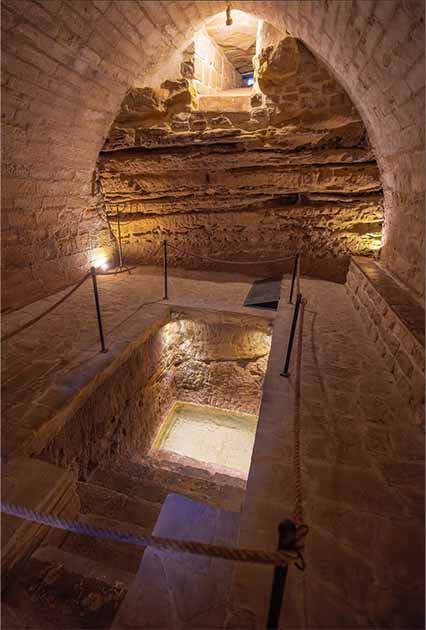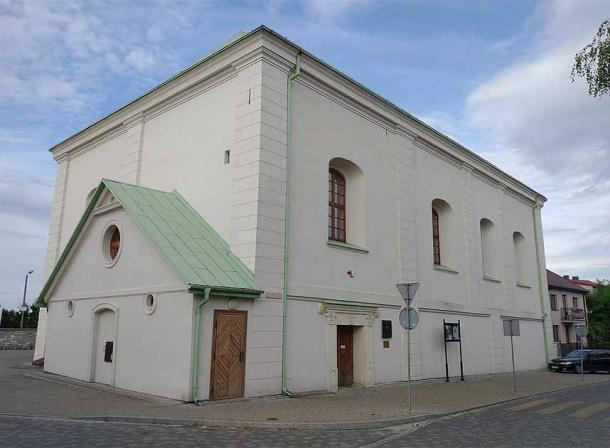
Sacred Jewish Ritual Bath Found Under Seedy Strip Club in Poland
The basement of a former strip club in the historic area of Lesser Poland, purchased 15 years ago, has accidentally revealed a historic Jewish site - a mikveh or Jewish ritual purification bath filled with water. Located in the erstwhile Jewish settled town of Chmielnik, the basement has another accompanying smaller mikveh used by women. The Jewish bath’s original blue and white floor tiles, with the Stars of David on the wall, exist as they have always.
“It’s astonishing,” said Meir Bulka, who advocates for the preservation of Jewish heritage in Poland, in an interview with Haaretz. “You enter the basement, and you’re in another world. It’s like a time capsule.”
The Sphinx nightclub, which once throbbed with life, lies woebegone with shuttered doors for nearly 15 years now. Entering it, a bar with a Heineken sign cling to the wall, and a pole where the dancers would do their work. The walls were adorned with Egyptian motifs, which are now in a crumbly state, accompany the mouldy walls and dripping ceiling, reports The Times of Israel.
A Mikveh or Jewish ritual bath discovered in basement of former strip club in #Polandhttps://t.co/zdGeBWRusl pic.twitter.com/DzEqxzBzE8
— Arkeonews (@ArkeoNews) August 25, 2023
Mikveh: A Commitment to the Jewish Faith
The primary purpose of a mikveh is to achieve ritual purity, which is important in various Jewish traditions and life events. In Judaism, there are specific circumstances and events where ritual purity is required. For example, a person may immerse in a mikveh before certain religious ceremonies or observances, such as Shabbat or holidays.
Women traditionally use a mikveh after menstruation to become ritually pure before resuming marital relations with their husbands. Individuals who are converting to Judaism typically undergo immersion in a mikveh as part of the conversion process. This immersion symbolizes a spiritual rebirth and commitment to the Jewish faith.
- Ancient Ritual Bath Found At Biblical Garden of Gethsemane
- Ancient Purification Rituals: Exploring Cleansing and Spiritual Renewal

An example of a ritual bath (Mikveh) at Synagogue of Water, Ubeda, Spain. Source: diegograndi / Adobe Stock.
Jews in Poland
Poland was one of the pre-war Nazi targets, subjected to severe atrocities owing to the huge Jewish population in pockets across the country. Chmielnik was settled by Sephardic Jews, who fled Spain after the Inquisition of 1638. In the late 19th and early 20th centuries, Chmielnik thrived with a Jewish population constituting approximately 80 percent of its 10,000 residents. The Jewish community built a synagogue there and contributed significantly to the town's diverse economic landscape, engaging in manufacturing, crafts, construction, and various professions.
Tragically, their post-war numbers were down to just 4, and the synagogue now serves as a museum and reminder of their historical and cultural presence. The museum features a meticulously reconstructed bimah and stunning murals. Among its prized exhibits is a Yiddish poster cautioning against praying near the bimah for those Jews who had shaved their beards.

The synagogue in Chmielnik, which is now a museum. (MOs810 / CC by SA 4.0)
The town's history took a dark turn when the German Nazi forces invaded Chmielnik and Poland on September 5, 1939. Prominent Jewish figures were rounded up and herded into a study hall, or a beit midrash, which was set ablaze. The survivors were condemned to forced labor and, in 1941, were confined to the town's ghetto.
In a tragic parallel to the events in Warsaw, Mordechai Anielewicz, leader of the Jewish Fighting Organization, made a futile visit to Chmielnik in the summer of 1942. He relayed the horrors of Warsaw and the extermination camps, urging the youth movements in the ghetto to prepare for resistance.
Yet, his plea went unanswered. In October 1942, SS forces, aided by Ukrainian, Lithuanian, and Latvian auxiliaries, extinguished the ghetto. Hundreds of Jewish residents met their demise, while thousands were deported to the Treblinka death camp.
This abandoned stripclub was purchased 15 years ago by Marian Zwolski, a businessman and amateur historian who grew up in Chmielnik. Zwolski operates a funeral home in nearby Kielce, which was the site of horrific anti-Semitic pogrom, killing 42 Jews. He hopes to turn the new mikveh into a tourist attraction, possibly a museum.
Top image: A Jewish mikveh ritual bath from Syracuse, Sicily (not the ritual bath reported in this article). Source: Zde / Adobe Stock.
By Sahir Pandey
References
Altuntas, L. 2023. A Mikveh or Jewish ritual bath discovered in basement of former strip club in Poland. Available at: https://arkeonews.net/a-mikveh-or-jewish-ritual-bath-discovered-in-basement-of-former-strip-club-in-poland/.
Aredet, O. 2023. New Owner of Abandoned Polish Strip Club Finds ‘Time Capsule’: Mikveh in Basement. Available at: https://www.haaretz.com/magazine/2023-08-19/ty-article-magazine/.premium/new-owner-of-abandoned-polish-strip-club-finds-time-capsule-mikveh-in-basement/0000018a-0ec3-d18f-a3fb-1fd7b3140000.
Gurvis, J. 2023. Owner of former nightclub in Poland discovers mikveh in basement. Available at: https://www.timesofisrael.com/owner-of-former-nightclub-in-poland-discovers-mikveh-in-basement/.















